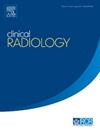Differentiation of benign, intermediate, and malignant soft-tissue tumours by using multiple diffusion-weighted imaging models
IF 2.1
3区 医学
Q2 RADIOLOGY, NUCLEAR MEDICINE & MEDICAL IMAGING
引用次数: 0
Abstract
AIM
The aim of this study was to determine whether intravoxel incoherent motion (IVIM) and diffusion kurtosis imaging (DKI) can differentiate benign, intermediate, and malignant soft-tissue tumours (STTs) of the extremities and trunk.
MATERIALS AND METHODS
We prospectively recruited 100 STT patients (32, 15, and 53 patients with benign, intermediate, and malignant tumours, respectively). The patients underwent IVIM and DKI, and the following parameters were measured: standard apparent diffusion coefficient (ADC), perfusion fraction (f), true diffusion coefficient (Dslow), pseudo-diffusion coefficient (Dfast), water diffusion heterogeneity index (α), distributed diffusion coefficient (DDC), mean diffusivity (MD), and mean kurtosis (MK). Statistical analyses were performed using receiver operating characteristic curves, the Kruskal-Wallis H test, and post hoc test with Bonferroni correction.
RESULTS
Standard ADC, Dslow, DDC, and MD values gradually decreased from benign to intermediate and malignant STTs. Intermediate STTs displayed a lower f value than benign tumours (P=0.029). The MK value was higher in malignant tumours than in intermediate and benign tumours (P=0.021 and <0.001, respectively). The DDC value best differentiated benign tumours from nonbenign (intermediate and malignant) tumours (area under the curve [AUC] = 0.884, 0853, and 0.892, respectively). The optimal MK cut-off value for differentiating intermediate and malignant tumours was 0.65 (sensitivity: 73.33%, specificity: 81.13%, accuracy: 79.41%).
CONCLUSION
IVIM and DKI parameters were helpful for differentiating benign, intermediate, and malignant STTs and can complement conventional MRI, with DDC and MK values showing high diagnostic efficacy.
利用多重弥散加权成像模型鉴别软组织良性、中度和恶性肿瘤
目的本研究的目的是确定体素内非相干运动(IVIM)和弥散峰度成像(DKI)是否可以区分四肢和躯干的良性、中度和恶性软组织肿瘤(STTs)。材料与方法我们前瞻性地招募了100例STT患者(分别为良性、中度和恶性肿瘤患者32例、15例和53例)。分别行IVIM和DKI,测定标准表观扩散系数(ADC)、灌注分数(f)、真扩散系数(Dslow)、伪扩散系数(Dfast)、水扩散非均质性指数(α)、分布扩散系数(DDC)、平均扩散系数(MD)、平均峰度(MK)。采用受试者工作特征曲线、Kruskal-Wallis H检验和事后Bonferroni校正检验进行统计分析。结果标准ADC、Dslow、DDC、MD值由良性stt逐渐降低至中恶性stt。中期stt的f值低于良性肿瘤(P=0.029)。恶性肿瘤的MK值高于中度肿瘤和良性肿瘤(P=0.021和<;0.001)。DDC值最能区分良性肿瘤与非良性(中恶性)肿瘤(曲线下面积[AUC]分别= 0.884、0853和0.892)。鉴别中恶性肿瘤的最佳MK临界值为0.65(敏感性:73.33%,特异性:81.13%,准确性:79.41%)。结论vim和DKI参数有助于鉴别良、中、恶性stt,可作为常规MRI的补充,其中DDC和MK值具有较高的诊断效能。
本文章由计算机程序翻译,如有差异,请以英文原文为准。
求助全文
约1分钟内获得全文
求助全文
来源期刊

Clinical radiology
医学-核医学
CiteScore
4.70
自引率
3.80%
发文量
528
审稿时长
76 days
期刊介绍:
Clinical Radiology is published by Elsevier on behalf of The Royal College of Radiologists. Clinical Radiology is an International Journal bringing you original research, editorials and review articles on all aspects of diagnostic imaging, including:
• Computed tomography
• Magnetic resonance imaging
• Ultrasonography
• Digital radiology
• Interventional radiology
• Radiography
• Nuclear medicine
Papers on radiological protection, quality assurance, audit in radiology and matters relating to radiological training and education are also included. In addition, each issue contains correspondence, book reviews and notices of forthcoming events.
 求助内容:
求助内容: 应助结果提醒方式:
应助结果提醒方式:


